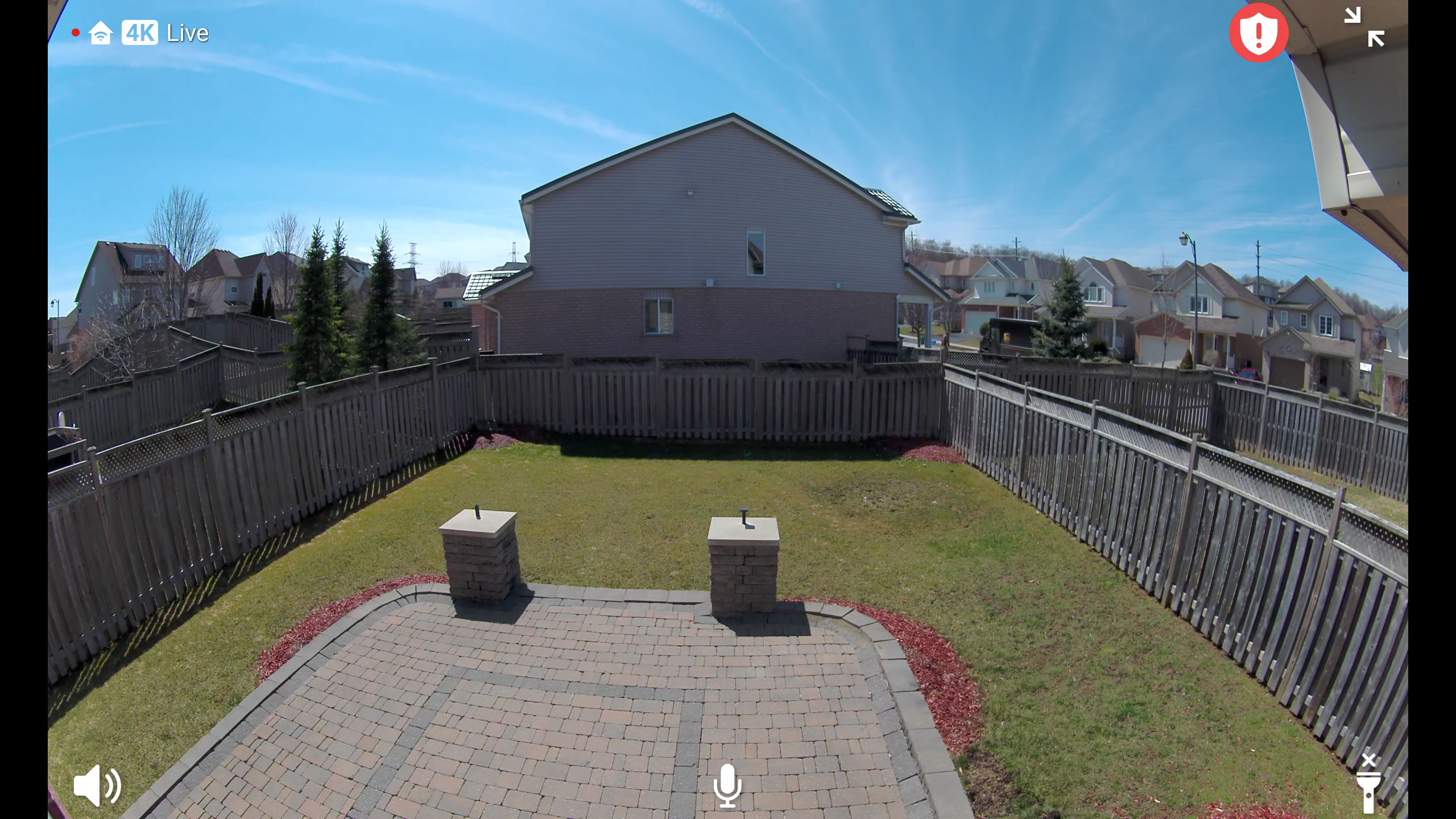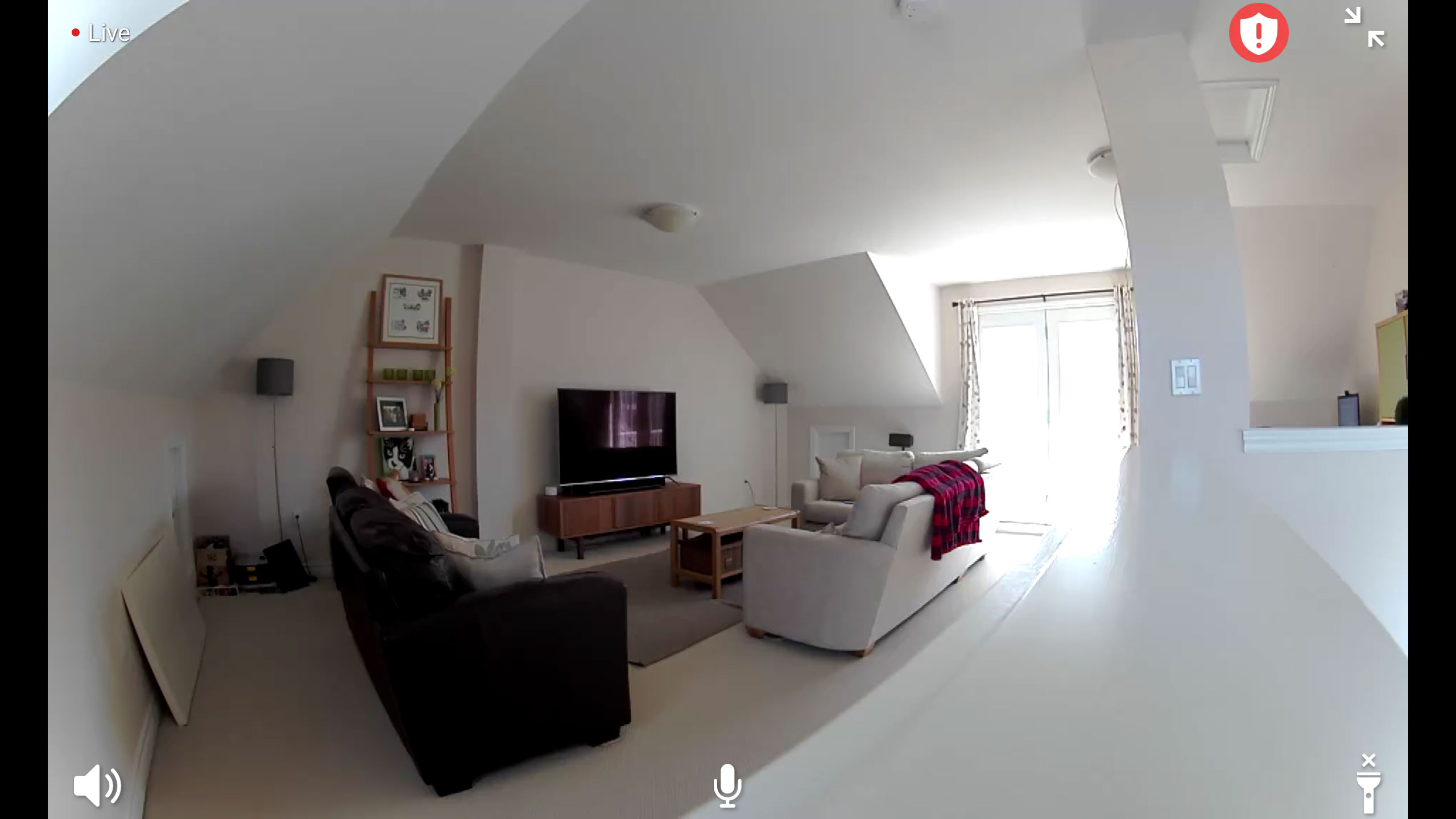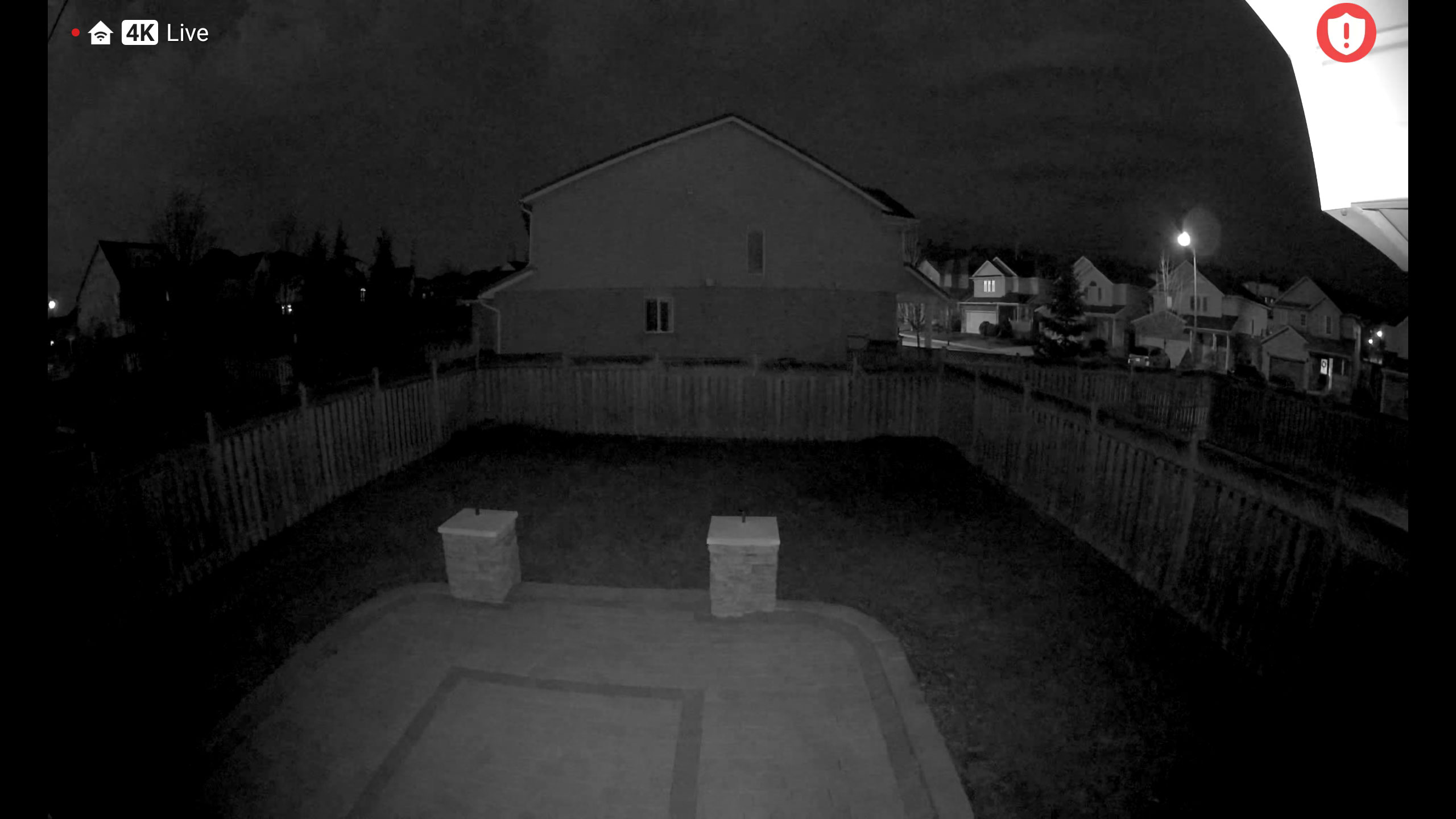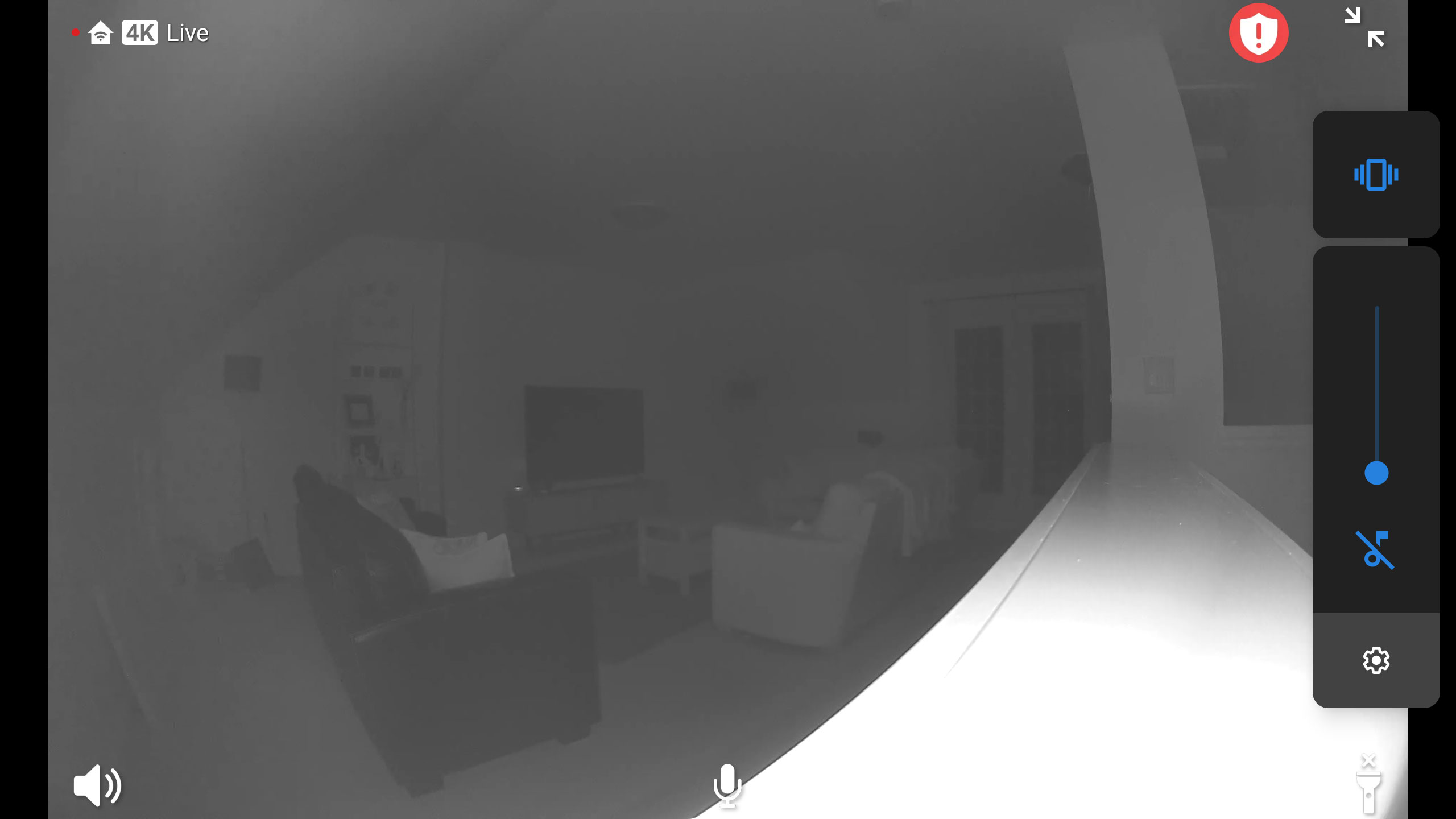- Beautifully crafted hardware design
- Weatherproof and wireless for indoor/outdoor use
- Fabulous 180-degree field of vision with little fish-eye distortion
- Decent two-way audio
- 4K UHD image clarity
- Some features unavailable when using 4K video settings
- No ability to view locally stored video without removing the microSD card
- Double-tiered subscription required for 4K cloud recording
The 4K UHD Smart Cam revolution is finally here. With a tsunami of solid-but-similar full HD security cameras landing on the shelves of electronics stores over the last few years, we’ve been patiently waiting for the next wave of innovation.
Last year’s Nest Cam IQ Outdoor came close, boasting a 4K sensor with HDR and a swathe of goodies including facial recognition and smart tracking, but even that device displayed video at 1080p resolution. With smart homes now packing multiple 4K TVs and UHD smartphone displays, it’s time for smart cams to step up to the plate and deliver new levels of image clarity and detail.
Impressive, UHD, field-of-view
Leading the way is the all-new Arlo Ultra 4K series. Priced from $400 for a single camera with the new Ultra Smart Hub, this next-generation device is packed with the latest smart cam tech.
A half-inch, 8-megapixel image sensor promises crystal-clear images at 3,840 × 2,160 resolution (1080p and 720p video modes are also available for those needing to conserve bandwidth).

A panoramic 180-degree field of view sees Arlo Ultra thumb its nose at competitors, with dual motion detection, advanced object detection, automatic tracking, and zoom, adding a healthy dollop of intelligence to the impressive spec list. Alongside color night vision support, an integrated spotlight boosts the camera’s security chops, chasing away the shadows with bright 6500K illumination, while an integrated siren will wake the household should an intruder be detected.
The panoramic 180-degree field of view sees Arlo Ultra thumb its nose at competitors.
Add a dual-microphone array with wind and noise cancellation for two-way audio, local recording to microSD, and fast, modern 802.11ac Wi-Fi connectivity, and it’s clear that Arlo Ultra is not your dad’s dusty old CCTV rig. Did we mention it’s wireless, weather-resistant, and happy to work indoors or outside in the elements? That, too.
In fact, there’s so much leading-edge tech here that the Arlo Ultra is sadly incompatible with older Arlo base stations. So, while you can purchase single add-on cameras for $100 less, you’ll need to invest in at least this entry-level bundle to make the leap to UHD. The good news is that the new SmartHub is backwards compatible with older cameras, including the original Arlo, Arlo Pro, and Arlo Pro 2 models.
Sleek lines and a rugged construction
In the midst of this smart cam revolution, thankfully not everything has changed. The gloss-white Arlo Cameras themselves are just as curvy and cute as their predecessors on the outside. At 3.5 × 2.0 × 3.1” (89 × 52 × 78mm) and weighing in at 11.6 oz. (331 g) they’re very slightly larger and heavier than the previous-generation Arlo Pro 2 cameras. A new chassis release design for installing Arlo Ultra’s rechargeable batteries and a new magnetic charging system suggests that Arlo’s designers have done more than a simple cut-and-paste job, crafting an elegant, compact smart cam that balances sleek lines with a rugged construction.
The new Arlo SmartHub is also quite slinky. It lacks the siren available on the old Arlo Base Station but loses some heft and new integration features in return. It connects to your router over Ethernet and secures video footage via a discrete, secure personal network. A microSD card slot is tucked into its base for local video recording, but you’ll need to provide your own card.
Packing a proprietary Arlo RF communications protocol for networking, the SmartHub will also allow third-party device connections in time, with support for Zigbee and Z-Wave coming later this year. The likes of Philips Hue, Sonos, Yale, and Bose are among a bunch of partners signed up to a “Works with Arlo” compatibility program slated for 2019. The idea is for Arlo to become the de facto smart home platform for your household, rather than a mere security player; time will tell if the idea gains traction, but with a host of major partnerships already announced, there’s certainly potential.
Painless setup with easy, magnetic mounting
We found setting up Arlo Ultra to be painless, guided by simple and friendly instructions from an accompanying smartphone app. Hook up the SmartHub to your router, then pair your cameras. It’s a breeze. Obviously, you’ll also need to find an appropriate installation point for Arlo Ultra. The beauty of a wireless, weatherproof system is that it works equally well indoors or out.
The camera’s flat base supports a simple shelf or desktop position, while a magnetic mount allows you to fix Arlo Ultra to a wall, ceiling, fence, and so on. A small screw and wall anchor are included in-box to secure the mount to your fixture of choice, and the camera snaps on. We were pleased to see a strong magnetic connection that holds the camera firmly in place while allowing easy positioning to ensure an optimal view of surroundings. A screw mount, connecting to the rear of the camera, is also included in some Arlo Ultra packages and is available to purchase separately.
Super-wide views with top-notch clarity
Having reviewed many smart cams over the last few years, two things about Arlo Ultra gripped us immediately. First, the 180-degree field of view offers impressively wide vistas – far greater than we’ve encountered on any smart cam to date. Even more astonishing is that the panorama is delivered with little fish-eye distortion, making Arlo Ultra a fine choice for outdoor surveillance.
We were similarly impressed by the fine quality of Arlo Ultra’s 4K video output, which is undoubtedly among the best you’ll find on a consumer smart cam today – next-generation clarity has arrived at last. We love the ability to zoom into the video preview in the Arlo app and not see any pixellation – the image remains sharp, clear, and true. You won’t be swamped by image setting controls either. A simple brightness slider allows you to carefully tweak the video for optimum quality – that’s all you need.
Our excitement here was tempered somewhat by the effort required to enable 4K streaming via the Arlo app. Not only is the highest video quality disabled in the app by default, there are also several restrictions around 4K streaming and recording that cause frustration – more on that shortly.
The 180-degree field of view offers impressively wide vistas.
We were less impressed with Arlo Ultra’s night vision quality, however. Indoors, in the depths of the night, we found images to be surprisingly foggy and lacking contrast at mid and long range. The camera’s integrated spotlight does a worthy job of illuminating spaces when motion is detected, serving as a strong deterrent for intruders.
Elsewhere, the camera’s integrated microphone does a very good job of recording and streaming reasonably clear audio. Two-way audio is also available from your smartphone with Arlo Ultra’s internal speaker, offering functional, if rather raspy, quality.
Feature failures and frustration
As we continued to explore Arlo Ultra’s features, unfortunately annoying compromises and basic failures in functionality became apparent. First, we were unable to get local recording to work to the formatted microSD card inserted into the Arlo SmartHub. The feature was enabled in the app, and the microSD card was registered as active and yet no clips were recorded by the camera.
Worse still, we had to remove the microSD card from the SmartHub and check for recordings on a computer, as there is no way to access local recordings over the network from the Arlo smartphone or available web app. This is a bizarre restriction for a storage device physically tethered to your router and one that Arlo states won’t be resolved until the second half of the year.
Auto Zoom and Tracking is a great feature we’ve encountered on leading smart cams, delivering intelligent tracking of moving objects (people) in the camera’s view with optimum quality.
When you enable it on Arlo Ultra, you’ll notice that 4K Local Streaming is simultaneously disabled.
The perfect feature for a 4K camera, you’d think, but when you enable it on Arlo Ultra, you’ll notice that 4K Local Streaming is simultaneously disabled. Why? According to a complicated support document, Arlo states that “certain features are specifically optimized for each setting.” Meaning this feature is available only on standard HD streams.
Tap through to test out other features and our frustration grew. Activity zones for pin-point motion detection and reduced false alarms? Without a subscription, they’re only when your camera is plugged into a power outlet. We were shocked to discover that even reasonably basic features like continuous video recording and a timeline view of captured clips all required a service plan.
Subscription feature-locks take the shine off an impressive array of features
While most smart cams are equipped with value-added plans for extended recording archives and some feature enhancements, Arlo Ultra is offered with a heavy reliance on subscription payments.
Without a service plan, you cannot benefit from cloud recording and must rely on live streaming and local SD storage. Activity zones are disabled, as are Arlo Ultra’s smart person and object detection features. You do receive a trial one-year subscription to the company’s Smart Premier service, supporting 1080p HD cloud recording, activity zones advanced person/object detection on up to 10 cameras.

After that has expired, you’ll need to stump up $10 a month to continue the plan (or opt for the entry-level Arlo Smart plan at $3 per camera/month). Surprisingly, even top-tier Smart Elite plan ($15 per month for up to 20 cameras) does not include 4K cloud recording. You’ll be nickel-and-dimed a further $2 a month on top of any service plan to enable Arlo Ultra’s highest quality cloud recording.
This nickel-and-dime approach to feature access would make a cable company blush.
We’re not big fans of feature-locked service subscriptions. A $400 investment in a high-class, 4K smart cam is understandable, but locking UHD cloud recording behind a double-tiered subscription plan feels excessive – particularly when basic features are missing or broken.
With the subscription enabled, life with Arlo Ultra certainly improves. Cloud recording and a timeline view of clips is a much-needed convenience, while we found the camera’s auto zoom and tracking feature to work reasonably well. Zooming and tracking were both a quite jerky – yet functional – but we did miss that promised 4K image quality. And behold, our local recordings suddenly became available when we reinserted our microSD card into a computer – including a lost archive of clips that were captured before we’d subscribed. Oh dear.
Warranty information
Arlo Ultra is supported by a 1-year limited warranty.
Our Take
From a technology perspective, the Arlo Ultra is every inch the next-generation smart cam we’ve been desperate for. Compact, sleek, and sufficiently versatile for indoor or outdoor use, its impressively-wide field of view and clear 4K UHD imaging leads the market. All of which makes the fact that the company is forcing service plans and subscription requirements on customers even more frustrating. We feel strongly that a $400 camera should offer a comprehensive array of features at no extra cost.
Arlo has taken a nickel-and-dime approach to feature access that would make a cable company blush. As such, having invested a lot of money in top-notch hardware, users will find themselves needing to invest hundreds of dollars extra to benefit from Arlo’s full suite of services once the one-year subscription runs out.
Is there a better alternative?
Arlo Ultra beats current smart cam contenders thanks to its versatility and top-class image quality. If you’re a connoisseur of consumer tech – with deep pockets – then Arlo Ultra is the camera to buy. Google’s pricey Nest Cam IQ Indoor and Nest Cam IQ Outdoor are certainly smarter cameras, but can’t match Arlo Ultra’s wireless convenience and powerful imaging.
If UHD pricing seems a little rich for your tastes, the $150 Swann Smart Security Camera offers wireless and weatherproof operation with decent HD image quality and a budget price.
How long will it last?
Place a bet on Arlo Ultra and you should find the hardware should last you for many years to come. Clearly, some mistakes have been made by the company during the camera’s development and launch. A series of subsequent firmware updates have appeased early adopters, and we were mostly pleased with performance. That said, we believe there’s still a way to go before Arlo’s developers and product managers complete development on basic, missing features and tweak their service plans to better balance feature access and cost.
Should you buy it?
If you’re a passionate smart home enthusiast who loves the latest tech (and let’s face it, you probably are) then you’ll love Arlo Ultra’s fine imaging. But be prepared for some underlying frustration. On hardware alone, it gets our recommendation. Everyone else should stay on the 1080p HD smart cam train for now while Arlo continues to refine this device and inevitable swathe of UHD competitors flood the market over the next twelve months.
















